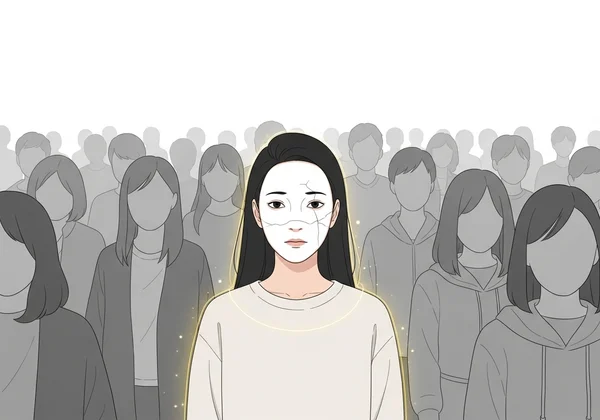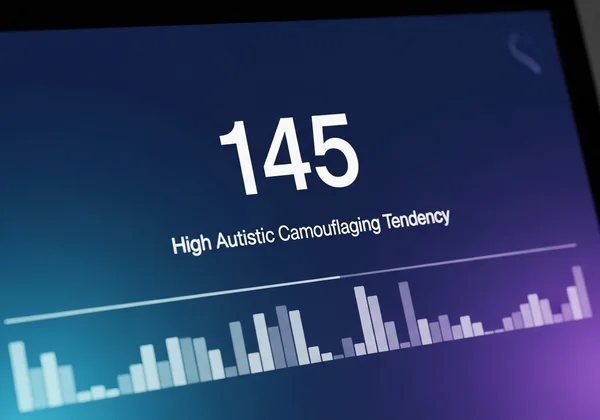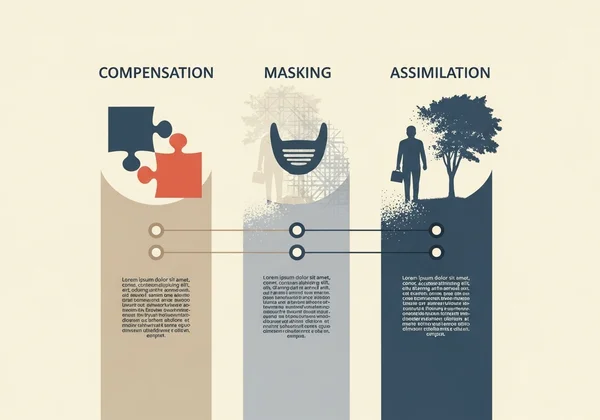CATQ Score Interpretation: Understanding Your Camouflaging
Have you completed the CATQ test and found yourself staring at numbers, wondering what they truly mean for your unique experience? What is a high score on the CATQ? This guide will help you understand your CATQ scores, offering deep insights into your autistic camouflaging behaviors and supporting your journey towards greater self-understanding. On our platform, we believe that understanding these patterns is the first step towards a more authentic and fulfilling life. Discover your scores and gain clarity by taking the free CATQ assessment today.
Autistic camouflaging refers to the conscious or unconscious strategies individuals use to mask or compensate for their autistic traits in social situations. This often leads to significant mental fatigue and can obscure an individual’s true self. The Camouflaging Autistic Traits Questionnaire (CATQ), developed by Hull et al. (2018), is a scientifically validated tool published in a peer-reviewed journal designed to quantify these behaviors, providing a valuable snapshot for self-exploration, particularly for adults, neurodiversity explorers, and LGBTQ+ individuals who may suspect they are on the spectrum.

Decoding Your Overall CATQ Score
Your total CATQ score interpretation offers a comprehensive overview of your general propensity to camouflage autistic traits. This single number reflects the combined intensity of various strategies you might employ to navigate a neurotypical world. This overall score offers a crucial starting point for self-reflection, showing how much energy you might be spending on daily social interactions.
What Your CATQ Total Score Reveals About You
The total CATQ score is derived from 25 questions, each rated on a 1-7 Likert scale. A higher total score generally indicates a greater reliance on autistic camouflaging strategies. For many, a high score resonates deeply with a long-held feeling of being different, often describing it as "acting" or performing in social settings. This can be particularly true for undiagnosed autism in adults, especially women, who often develop sophisticated camouflaging techniques that lead to missed diagnoses. While the CATQ is not a diagnostic tool, a significant score can validate your experiences and encourage further self-discovery.

Understanding the CATQ Score Range and What it Implies
The CATQ score range typically extends from 25 to 175. Scores leaning towards the higher end suggest more frequent and intense camouflaging behaviors, encompassing various strategies from compensation to assimilation. Conversely, lower scores might indicate less reliance on these strategies. It’s important to remember that there's no "good" or "bad" score; it simply reflects your current patterns. What matters is how these patterns impact your well-being. Many individuals find that a high catq scoring indicates why they experience significant autistic burnout after social engagements. If you haven't taken the test yet, you can start your journey on our homepage.
The Three Pillars of Autistic Camouflaging: Compensation, Masking, and Assimilation
Beyond the overall score, the CATQ provides insights into three distinct sub-scales: Compensation, Masking, and Assimilation. Each subscale sheds light on different facets of how individuals manage their autistic traits in social contexts. Understanding these individual scores provides a more nuanced CATQ score interpretation, allowing for targeted self-reflection.

Compensation: Cognitive Strategies for Social Situations
Compensation: cognitive strategies for social situations refers to the conscious intellectual efforts used to manage social interactions. This involves deliberately planning conversations, mimicking body language, or rehearsing responses. People employing autism compensation strategies might study social norms or observe others closely to understand expected behaviors. It's like learning a complex script for every social scene. For instance, someone might compensate by creating mental lists of appropriate small talk topics to avoid awkward silences. This strategic effort often feels mentally taxing, contributing to feelings of exhaustion.
Masking: The Act of Hiding Autistic Traits
Masking: the act of hiding autistic traits involves suppressing or concealing natural autistic behaviors. This can manifest as forcing eye contact, modulating vocal tone to sound more "typical," or actively suppressing stims (self-stimulatory behaviors). It’s about presenting a neurotypical facade to avoid perceived social judgment or to blend in. This consistent suppression can be incredibly draining, leading to feelings of inauthenticity and severe mental fatigue. Many who recognize this in themselves are seeking an autistic masking test to validate their experiences. You can take a scientifically validated one to identify masking behaviors on our site.
Assimilation: Blending In and Minimizing Differences
Assimilation: blending in and minimizing differences describes the process of adapting one's identity and behaviors to align with social expectations, often to avoid standing out. This goes beyond just hiding traits; it's about actively trying to become indistinguishable from neurotypical peers. It involves internalizing social norms to such an extent that the individual genuinely tries to minimize their perceived differences. The line between masking vs assimilation autism can be subtle, but assimilation suggests a deeper, more integrated attempt to conform. This continuous effort to disappear into the crowd can erode one's sense of self and lead to a profound feeling of disconnection.
Connecting Your CATQ Scores to Your Lived Experience
Understanding your CATQ scores is not just about numbers; it's about connecting these scientific insights to your unique everyday experiences. This connection is vital for genuine self-understanding and moving towards a more authentic way of being.
How Your Subscale Scores Impact Daily Interactions
Your scores on compensation, masking, and assimilation can highlight which strategies you predominantly use and how they impact your daily life. A high compensation score might mean you meticulously plan social outings, while a high masking score could explain why you feel utterly drained after a simple conversation. Understanding these specific patterns helps you pinpoint the sources of your social fatigue and the areas where you might be expending the most energy. This personalized insight can be deeply validating, confirming that your struggles are real and understandable. For deeper insights tailored to your specific answers, consider exploring the AI personalized report offered by CATQ.
Recognizing Your Unique Camouflaging Patterns for Self-Discovery
Recognizing your unique camouflaging patterns is a powerful step in your self-discovery journey. Perhaps you've always felt like an impostor, or you've experienced high functioning autism in women where your internal experience contradicts external perceptions. Your CATQ results can offer a framework for understanding these feelings. By identifying which aspects of camouflaging you engage in most, you can begin to consciously choose when and where to deploy these strategies, or even to reduce them. This newfound awareness allows for greater self-acceptance and provides a foundation for living more authentically, ultimately reducing autistic burnout and promoting mental well-being.
Empowering Self-Understanding Through Your CATQ Scores
Your CATQ score interpretation is more than just a measurement; it’s a tool for empowerment. It offers a validated perspective on your autistic camouflaging behaviors, helping you articulate experiences that might have previously felt vague or isolating. For many, understanding their scores marks a pivotal moment, providing the language and framework to discuss their internal world with others or with a mental health professional.
This awareness can lead to significant shifts, allowing you to prioritize self-care, set healthier boundaries, and cultivate environments where you can be your true self. The journey of self-discovery is ongoing, and the CATQ can serve as a guiding light. To gain your own insights and begin this transformative process, we invite you to explore your traits by taking the free CATQ assessment on our website. Our optional AI personalized report offers even deeper, scene-specific analysis, providing actionable advice for navigating your unique experiences.

Disclaimer: The CATQ test and its interpretation on this website are intended for informational purposes and self-exploration only. They do not constitute a medical diagnosis or substitute for professional medical advice. If you suspect you may be autistic or are experiencing significant distress, please consult a qualified healthcare professional for a proper assessment and guidance.
Frequently Asked Questions About CATQ Scores and Camouflaging
What is a high score on the CATQ test?
A high score on the CATQ test generally indicates a greater tendency to engage in autistic camouflaging behaviors. While there's no official "cut-off" for an autism diagnosis, higher scores reflect more frequent or intense use of social strategies like masking assimilation or compensation to blend in. Individuals with higher scores often report feeling exhausted by social interactions. You can take the scientifically validated CATQ online test on our site.
Is there a cut-off score for the CATQ to be autistic?
No, there is no cut-off score for the CATQ to be autistic. The CATQ is a self-report questionnaire designed to measure camouflaging behaviors, which are common in autistic individuals, but it is not a diagnostic tool for autism itself. Its purpose is to provide insights for self-understanding and personal reflection, not to offer a clinical diagnosis. For a formal autism diagnosis, consult a qualified healthcare professional.
How do I know if I'm masking autism symptoms?
You might be masking autism symptoms if you consistently feel mentally exhausted after social events, consciously try to imitate others' social behaviors, suppress natural movements or expressions, or feel like you're "performing" in social settings. A high score on the CATQ can strongly indicate that you are engaging in significant autistic masking. The social camouflaging scale within the CATQ can help you identify these patterns. Learn more by taking the free assessment.
What is the difference between autistic masking and camouflaging?
Autistic camouflaging is an umbrella term encompassing all strategies used to hide or compensate for autistic traits, including cognitive strategies, mimicry, and impression management. Autistic masking is a specific form of camouflaging that involves the direct suppression or concealment of one's natural autistic behaviors or expressions. Essentially, masking is a component of the broader concept of camouflaging. The CATQ helps differentiate between these nuanced behaviors.
Can I be autistic and not know it if I have a high CATQ score?
Yes, it is possible to be autistic and not know it even with a high CATQ score, especially for adults. Many individuals, particularly women and those who are able to masking assimilation effectively, remain undiagnosed into adulthood because their camouflaging behaviors hide their autistic traits. A high CATQ score often validates these experiences of feeling different or struggling in social settings. While the CATQ isn't a diagnostic tool, it can be a valuable indicator for self-reflection and prompt you to seek professional evaluation if desired. Discover your own CATQ test results on our website.